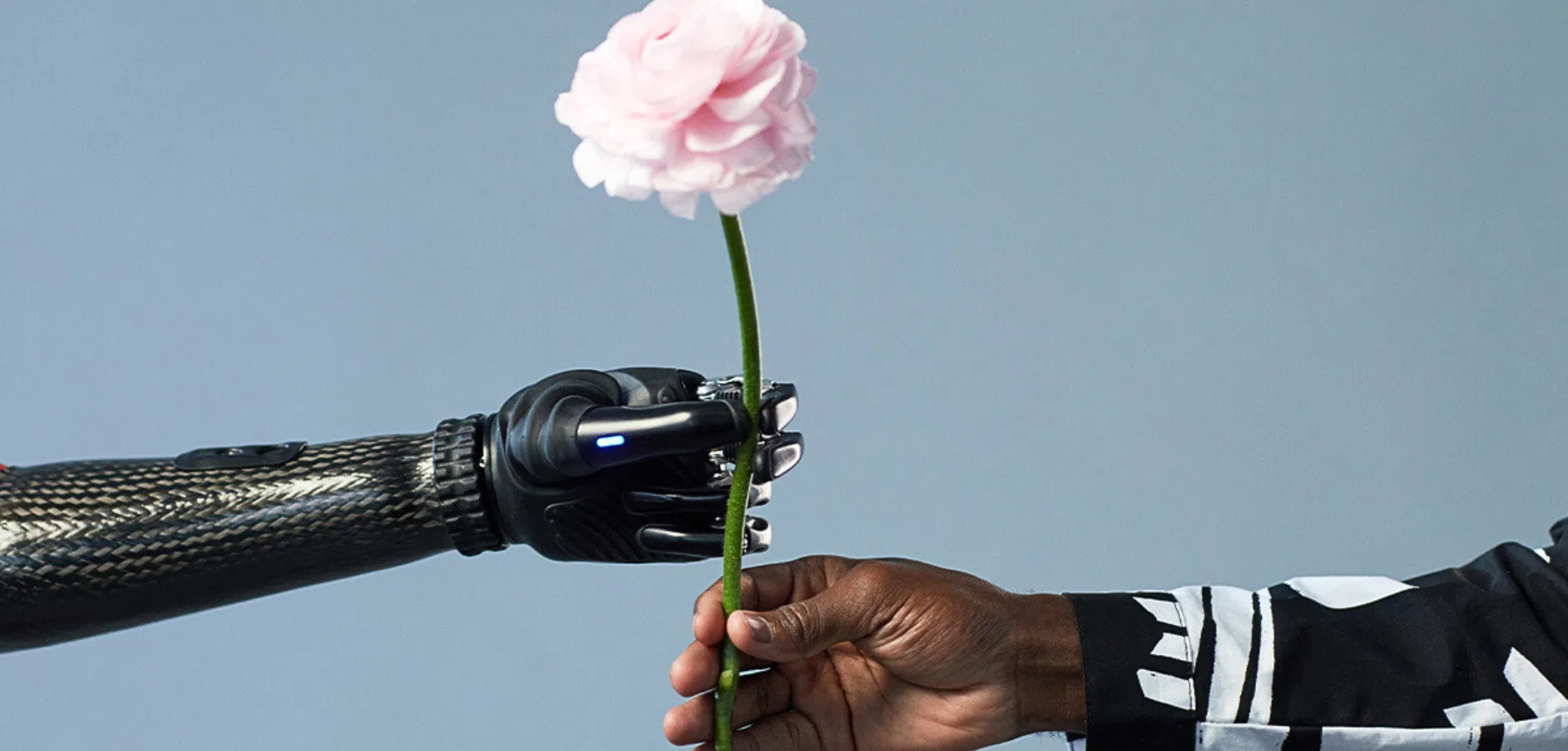You’ve spent weeks lining up creators, briefing them, and waiting for the content to go live. The likes, comments, shares start rolling in, and for a moment, it feels like momentum.
But then the doubt creeps in. Did you choose the right influencers? Is all that engagement actually moving the needle, or is it just noise?
This uncertainty isn’t unique—measuring return on investment (ROI) ranks as marketers’ second biggest challenge in creator campaigns. With the creator economy hitting $33 billion by 2025, these manual bottlenecks are holding back growth that should be scalable.
Here’s where AI changes everything. Instead of gut feel, you get predictive data. Instead of post-campaign analysis, you optimize in real time.
This blog outlines a five-function framework for using AI to transform creator campaigns: discovery, planning, monitoring, optimization, and analysis. Nearly two in three industry leaders expect AI to redefine influencer marketing in 2025—marketers who don’t adapt risk being left behind.
The five core functions framework: Using AI for creator content optimization
To cut through the buzzwords, marketers need a practical way to use AI. The five core functions framework shows how AI can support every stage of a creator campaign in 2025 and turn strategy into something measurable, repeatable, and scalable.
Start small: Focus on one AI function at a time, targeting your biggest pain point first. This allows you to test how it works and ensure it integrates with your existing technology stack.
The five core functions framework:
- Creator discovery and vetting
- Campaign planning and brief development
- Content performance monitoring
- Campaign optimization and amplification
- Performance analysis and learning
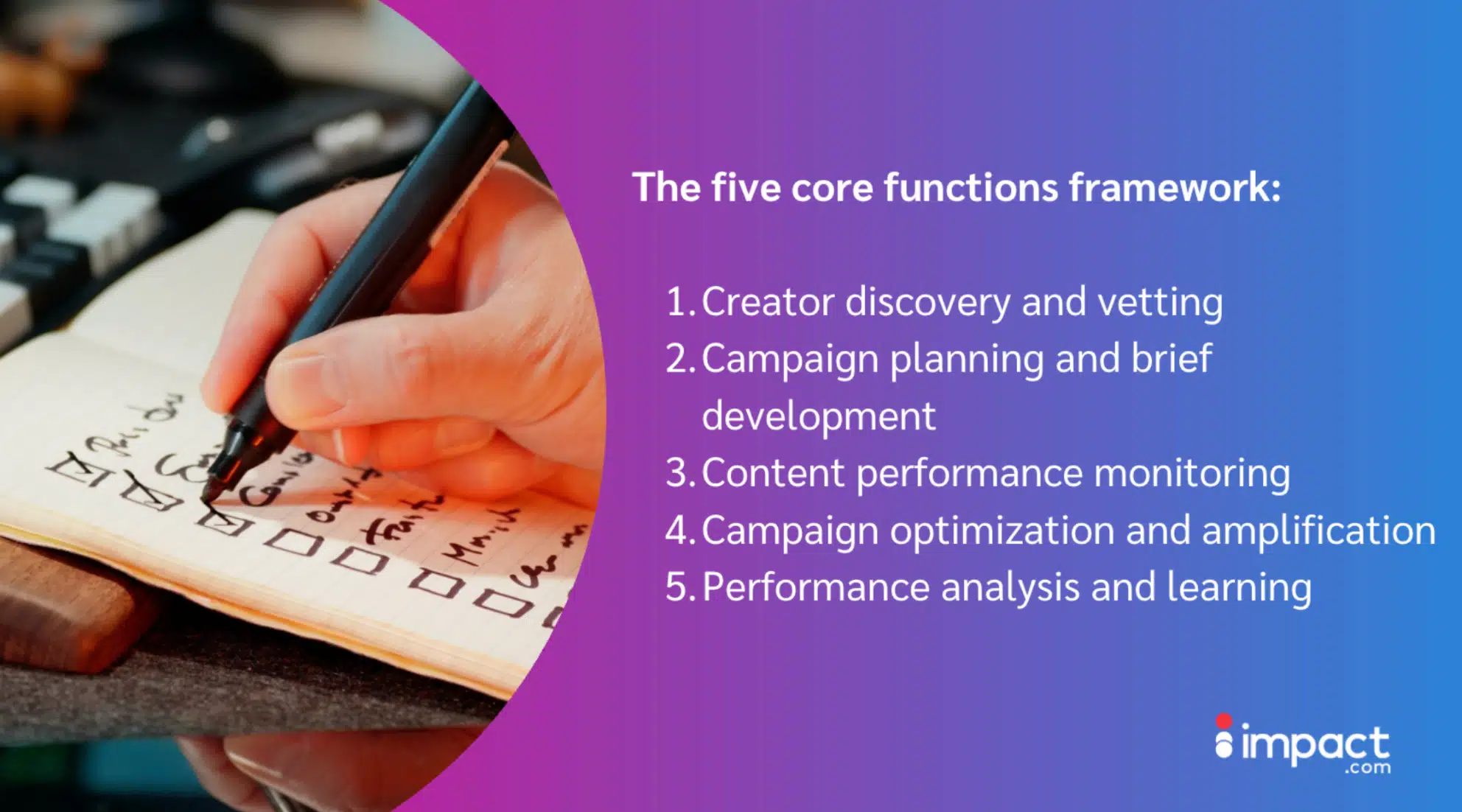
1. Creator discovery and vetting
Pain point
Finding the right creator should be a strategic process, but often it feels like guesswork. Many marketers still depend on time-consuming processes like:
- Manual reviews
- Keyword searches
- Follower counts
That means hours lost sifting through content, only to end up with partnerships built on surface-level metrics instead of genuine audience alignment. With so much creator content online, what should be a goldmine of insight often becomes an overwhelming burden.
AI transformational potential
AI flips that dynamic. Instead of chasing vanity metrics, AI tools can analyze a creator’s:
- Tone
- Past content
- Audience sentiment
These insights will help you uncover real brand alignment. They highlight which creative assets have historically performed best, and identify patterns that resonate most with audiences.
By automating this analysis, AI removes the heavy lifting from discovery, so you cut through the noise and focus on creators who are a true strategic fit.
Real-world implementation
Wellness brand Apollo Neuro teamed up with OAK Digital agency and impact.com’s AI-powered platform to expand beyond its core biohacker audience.
By analyzing historical content, reviews, and audience sentiment, the brand discovered the product’s key audience. It resonated most with people facing stress, anxiety, and insomnia.
These AI-powered insights helped the brand refine its creator mix and messaging, resulting in:
- New partners generating 36 percent of brand revenue
- Content creators reaching male audiences driving 22 percent of traffic
- Content partners bringing in 15 percent of program revenue

When rethinking discovery and vetting, ask yourself:
- What is the business cost of misaligned partnerships?
- How can AI reduce the risk of campaigns falling flat?
- Beyond follower count, what criteria define the ideal creator partner for your brand?
2. Campaign planning and brief development
Pain point
Planning a creator campaign often feels like a roll of the dice. Marketers set expectations and draft briefs based mostly on limited data and gut instinct.
Without deeper insights, briefs often default to vague directions like “make it visually appealing” or “highlight the benefits”, so there’s too much up to chance. The process is often driven more by guesswork than strategy.
AI transformational potential
AI changes that by bringing predictive power into the planning stage. AI analyzes a creator’s past content and audience engagement, and then forecasts how a campaign is likely to perform before launch.
Currently, 13 percent of AI applications in influencer campaigns are dedicated to predictive analytics. These insights let you set realistic goals and craft smarter and more effective briefs.
Instead of generic guidance, brands can give creators clear recommendations on:
- Messaging most likely to resonate with their audience
- Calls to action (CTAs) that drive engagement and conversions
- Visual styles proven to perform best
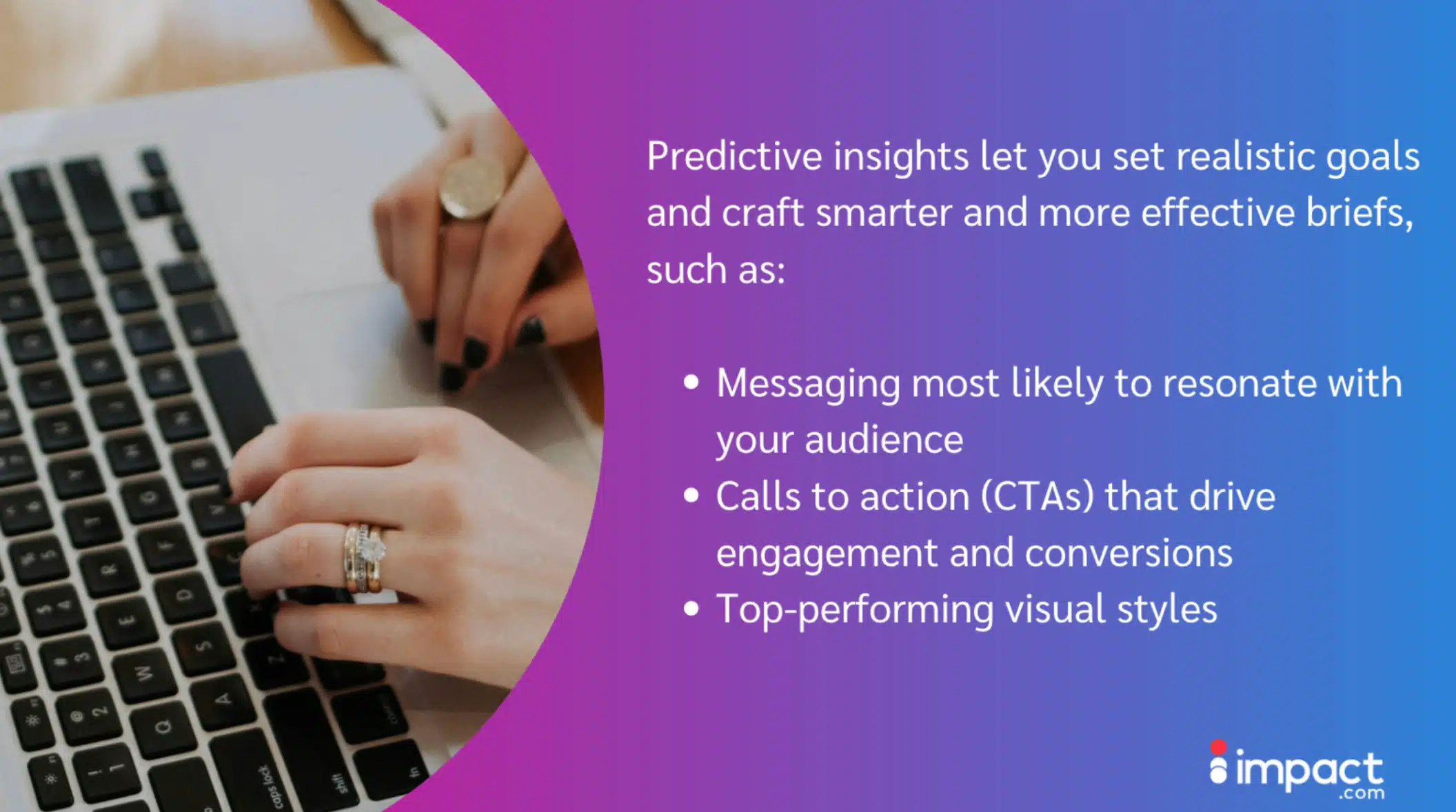
Real-world implementation
Marketers and agencies reap the rewards of early adoption. Kristina Nolan, VP of Media Services at DMi Partners explains, “AI-powered tools help us predict virality with greater accuracy, so we’re ahead of trends that inform smarter content strategies for our creators.”
In other words, marketers no longer have to play catch-up. With AI, they can shift from reactive to proactive. It’s easier to design strategy-aligned campaigns before a single post goes live.
Let’s apply this to a skincare brand. In the past, briefs went no deeper than “make it visually appealing” or “highlight the benefits.”
AI could reveal that before-and-after photos or posts shot in natural light consistently outperform other formats. Armed with this data, the brand can deliver tailored briefs that set creators up for success, maximizing performance and cutting wasted spend.
When planning your next campaign, ask yourself:
- How can we make our briefs data-driven instead of relying on creative hunches?
- Which metrics will help us set realistic, measurable goals before launch?
- How can we use AI insights to advise creators on messaging and visuals that maximize impact?
3. Content performance monitoring
Pain point
Measuring content performance has never been easier thanks to AI. Yet many marketers still find themselves buried in the wrong numbers. Likes and shares may look good on a dashboard, but they rarely tell you if a campaign truly drove impact.
The challenge only intensifies in hybrid influencer–affiliate marketing programs. Creators may spark awareness and generate conversions, but without the right tools, it’s nearly impossible to trace how they influence the buyer journey from first click to final purchase.
AI transformational potential
AI clears the fog. Rather than stopping at surface-level engagement, AI-powered tools connect content directly to the outcomes that matter:
- Clicks
- Leads
- Sales
Sentiment analysis goes deeper, scanning millions of daily mentions to reveal the emotions behind engagement: excitement, frustration, or genuine loyalty.
With advanced attribution models layered in, marketers can see the full picture, tracking exactly how creator-affiliate partners shape results at every stage of the funnel.
Real-world implementation
Resident, the bedding and mattress brand known for turning sleep into a science. Rather than relying on hunches, the team leaned on impact.com’s AI-powered performance tracking to fine-tune their user-generated content (UGC) within a hybrid influencer–affiliate program.
The difference was immediate. Instead of guessing what might stick, Resident zeroed in on the real questions consumers ask when shopping for a mattress:
- Will it ease my back pain?
- Is it worth the price?
- How does it compare to others?
These insights helped the team optimize creator content, guiding consumers along their purchase journey. The result? Double the value of each post and video, significantly boosting profitability.
As Jennifer Betz, VP of Affiliates, Influencers, and Partnerships at Resident, explained: “With impact.com’s platform, we were able to make data-driven decisions for future campaigns while continuously testing and refining our strategies.”

To shift from vanity metrics to meaningful results, ask yourself:
- How can we go beyond surface metrics to understand the emotional pulse of our audience?
- Which key performance indicators (KPIs) truly connect creator content to tangible outcomes like revenue or customer retention?
- How can we use AI-driven data to prove our impact in an era where every dollar must be justified?
4. Campaign optimization and amplification
Pain point
For many teams, brand safety feels reactive. Teams manually check content for compliance or missing ad disclosures, eating up hours that could be spent on strategy.
Testing new messages, platforms, or formats isn’t much better. The process is often slow, inconsistent, and tough to scale across regions.
AI transformational potential
AI flips the script by making optimization proactive. Automated tools flag risks in real time, such as:
- Unapproved terms
- Missing disclosures
- Off-brand content
AI catches these problems early, before they snowball.
Plus, AI can run rapid A/B tests on headlines, visuals, or CTAs. It analyzes results mid-campaign and delivers instant recommendations. The payoff is that teams can double down on what’s working, fix what’s not, and amplify impact while the campaign is still live.
Real-world implementation
Beauty brand L’Oréal has been a pioneer in adopting AI, leveraging the technology to quickly tailor visuals and messaging for platforms like TikTok and Instagram.
In just hours, L’Oréal localizes its content, ensuring campaigns resonate with diverse audiences on a large scale. This approach enhances engagement and maintains strict compliance with brand guidelines.
This is a good case of a brand using AI as an efficiency tool. “This isn’t experimentation anymore,” says Mark Lallemand, CMO of Western Europe at L’Oréal, “this is a marketing transformation with AI at the core of brand interactions. We used to turn around campaigns in weeks, now we do it in hours.”

As you think about optimization, ask yourself:
- How can AI help us stay ahead of brand safety risks instead of reacting after the fact?
- What’s the most efficient way to test and refine our content while campaigns are live?
- How can we empower creators with real-time feedback that boosts performance, not just post-campaign reports?
5. Performance analysis and learning
Pain point
For many marketers, the end of a campaign doesn’t bring relief. It can mean hours of tedious reporting. Your teams may sink hours into:
- Compiling data across platforms
- Creating wrap reports
- Extracting insights
Worse, traditional reports often stop at surface-level metrics, so it’s hard to understand why certain content resonated.
AI transformational potential
AI changes that. Instead of hours of manual work, AI instantly generates presentation-ready wrap reports that summarize:
- Performance
- Top-performing channels and creators
- Surface actionable insights
AI doesn’t stop at the numbers. It can analyze sentiment, uncover emotional triggers, and pinpoint the creative elements, like on-screen text or visual style, that actually drive conversions.
These insights turn reporting from a look in the rearview mirror into a tool for shaping smarter strategies ahead.
Real-world implementation
iStock by Getty Images understands the transformative potential of generative AI. To enhance its partnership program, the brand turned to impact.com, leveraging the platform’s powerful Data Lab tool to uncover valuable insights from a diverse range of creators.
By analyzing this data, the team created a detailed report that empowered them to:
- Make smarter, data-driven decisions
- Optimize their partnership strategies
- Identify success factors to guide future collaborations
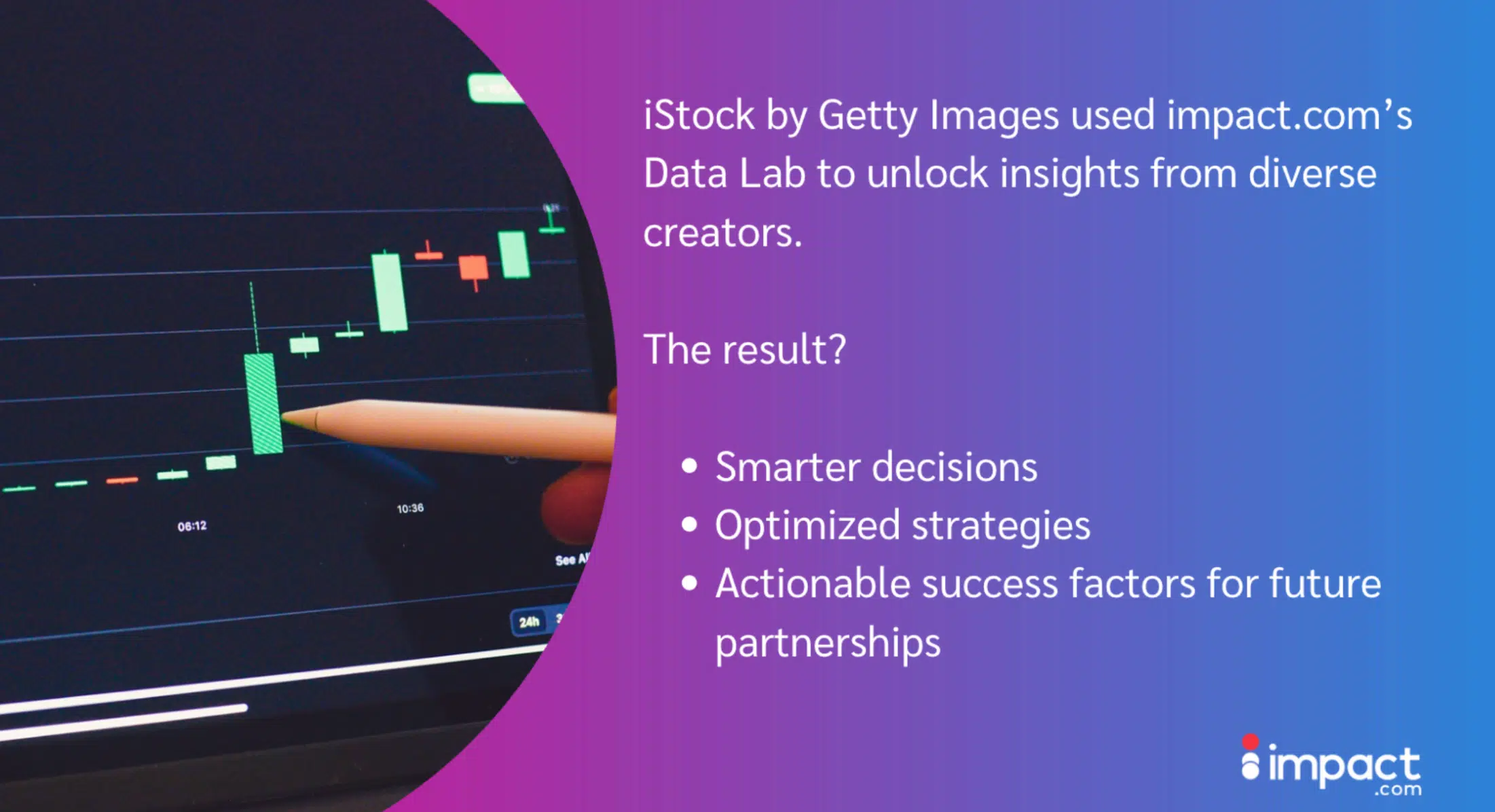
As you think about performance analysis, ask yourself:
- How can we get actionable wrap reports without hours of manual effort?
- How can AI help us understand the “why” behind success, not just the “what”?
- How can we use today’s insights to make the next campaign more efficient and effective?
From strategy to action: how to build your AI implementation roadmap
By now, you’ve seen how AI can reshape every stage of a creator campaign. But knowing the potential is only half the battle.
The real challenge lies in moving from theory to execution.
Marketers need a clear path forward:
- How to adopt AI tools
- Where to start
- How to scale without disrupting existing workflows
That’s where an AI implementation roadmap comes in. This section breaks down the practical steps you can take to turn strategy into action.
Maturity assessment: where to begin
The smartest way to implement AI isn’t to jump on every shiny new tool. Aim to start with where your team feels the most pressure.
Take an honest look at your current workflows:
- Where do you spend the most time?
- What tasks consistently hold you back from higher-value work?
A function-first approach ensures you prioritize AI investments by business impact, not just the latest tech trend.
Start with solving your biggest pain point. If your team is drowning in manual content reviews, automate that first. If reporting chews up whole afternoons, AI-generated wrap reports could deliver the quickest win.
The key is focus. Don’t try to overhaul all five core functions simultaneously. Pick one area where the efficiency gains will be obvious and immediate.
Tackling a single bottleneck first helps you prove ROI quickly, build momentum, and lay the groundwork to scale AI across your entire creator marketing strategy.

Integration: making AI a seamless co-pilot
AI isn’t a standalone solution. It’s a co-pilot for your existing team and technology.
To make the most of your AI investment, you need to think beyond a single tool and focus on how it integrates with your existing marketing technology stack.
The goal is a seamless flow of data that turns isolated metrics into actionable insights you can use immediately.
Start by asking:
- Does this tool connect with our other platforms?
- What is the quality of our data?
- Can we roll out AI in phases?
| Integrating AI into your current tech stack | |
|---|---|
| Brand tip | Method |
| Choose AI tools that connect to other platforms you use | Choose AI tools with open APIs that integrate easily with CRM, social media, and analytics platforms for seamless data flow and a full-funnel view of impact. |
| Ensure you feed AI with high-quality data | AI accuracy depends on clean, organized data. Prepare historical data (e.g., past campaign performance, audience demographics) to ensure reliable predictions and insights. |
| Roll out AI in phases | Start with a phased rollout by integrating AI into a single high-priority function, like performance monitoring or reporting. This will build team comfort and prove ROI for broader adoption. |
Investment prioritization: an ROI-based framework
In a budget-conscious world, every marketing dollar must prove its worth to stakeholders. That’s why AI investments should be judged by one standard: its ability to deliver tangible business outcomes.
The goal isn’t to chase trends. It’s to back tools that truly move the needle on metrics that matter, including:
- Clicks
- Sales
- Conversions
- Long-term customer value
The right AI platforms take you beyond vanity metrics like likes and shares. They reveal the full-funnel impact of creator campaigns, turning abstract engagement into actionable insights.
With that clarity, marketers can optimize strategy in real time, prove ROI with confidence, and secure the budgets they need to keep growing.
When evaluating where to invest, ask:
- Will this tool help us connect creator activity to revenue-driving outcomes?
- Does it deliver actionable insights we can use to optimize strategy immediately?
- Can it scale with our needs, ensuring sustainable and measurable growth?
Change management: preparing your team
AI isn’t here to replace marketers. It’s here to act as a productivity booster. The first step in change management is making that crystal clear.
Frame AI as the tool that takes care of repetitive, data-heavy work. The idea is your team will have more time to double down on the human side of marketing:
- Building relationships
- Crafting stories
- Shaping strategy
Smooth adoption also requires training and support. So, give your team hands-on guidance to get comfortable with AI-augmented workflows.
As AI automates tasks like reporting, content reviews, and compliance checks, encourage them to reinvest the time saved into strengthening creator partnerships and advancing creative ideas.
At its core, marketing still runs on the things AI can’t replace: authentic connections and human creativity. The brands that win will be the ones that treat AI as an ally, not a rival. They’ll use AI to handle the grunt work, while people focus on the relationships and ideas that truly move audiences.
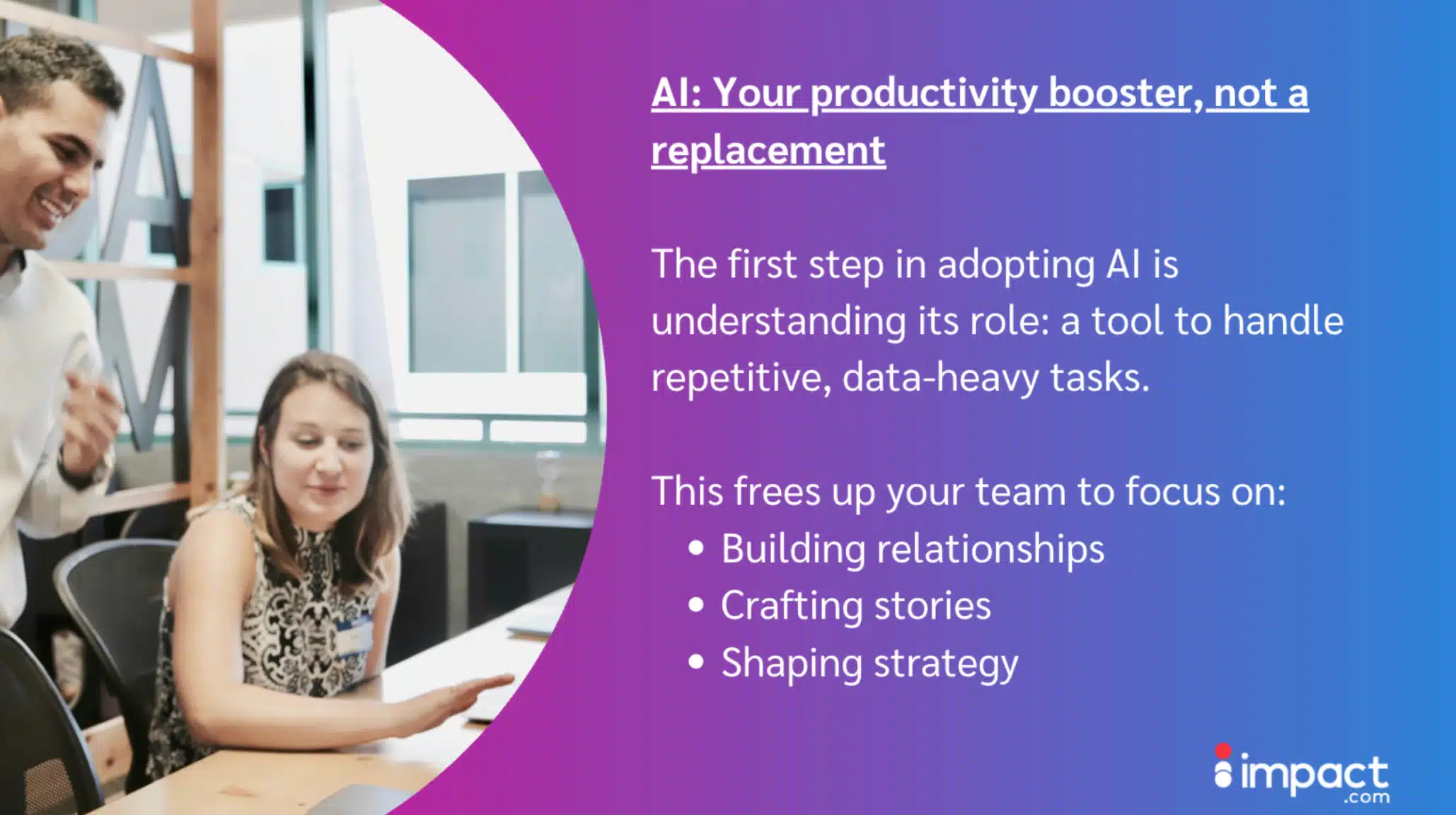
Success measurement: KPIs for AI implementation
If you want to prove the value of AI in your creator campaigns, start with the right scorecard. The key is to track function-specific KPIs that directly tie to business outcomes.
Instead of vague measures, these numbers show whether your AI investment actually drives the results you can take to the boardroom.
1. Creator discovery and vetting
- Time savings: Track the reduction in hours spent manually reviewing and vetting potential creators.
- Partner quality: Measure the percentage of new partners that are a strategic and authentic fit for the brand.
2. Campaign planning and brief development
- Predictive accuracy: To validate AI models, compare the predicted campaign performance (e.g., engagement rates) against real results.
- Brief efficiency: Measure the time saved in creating data-driven content briefs.
3. Content performance monitoring
- Sentiment shift: Track the real-time change in audience sentiment (e.g., positive vs negative mentions) to gauge brand perception.
- Beyond vanity metrics: Measure the direct link between content performance and tangible business results, such as clicks, leads, and sales.
4. Campaign optimization and amplification
- Brand safety compliance: Measure the reduction in brand safety violations and unapproved content flagged by the AI system.
- Conversion rate: Track the increase in conversions or engagement from mid-campaign optimizations informed by AI-powered iterative testing.
5. Performance analysis and learning
- Reporting time: Track the time saved in generating comprehensive campaign wrap reports.
- Actionable insights: Measure how insights from one campaign, such as top-performing channels or creators, are used to inform and improve the next strategy.
By zeroing in on these KPIs, you can show more than proof that AI works. You can demonstrate its real value of delivering measurable impact at every stage of the creator campaign life cycle.
Strategic implications: the new marketer’s role
As automation takes on heavy lifting, your role shifts. No more chasing tasks. Instead, you’re more likely to spend your time steering strategy, building relationships, and driving innovation.
The real opportunity isn’t efficiency alone. It’s using AI to future-proof your brand and sharpen your competitive edge.
Competitive advantage timing
In creator marketing, timing is everything, and that includes adopting AI. With 94 percent of marketers already using AI, the chance to gain a first-mover advantage is shrinking fast. Wait too long, and the risk is inefficiency and even irrelevance.
The future will favor those who can build AI-powered operational excellence across every stage of a campaign (the five core functions):
- Discovery
- Planning
- Monitoring
- Optimization
- Analysis
Brands that move now will set the pace, winning on efficiency, scale, and measurable results.
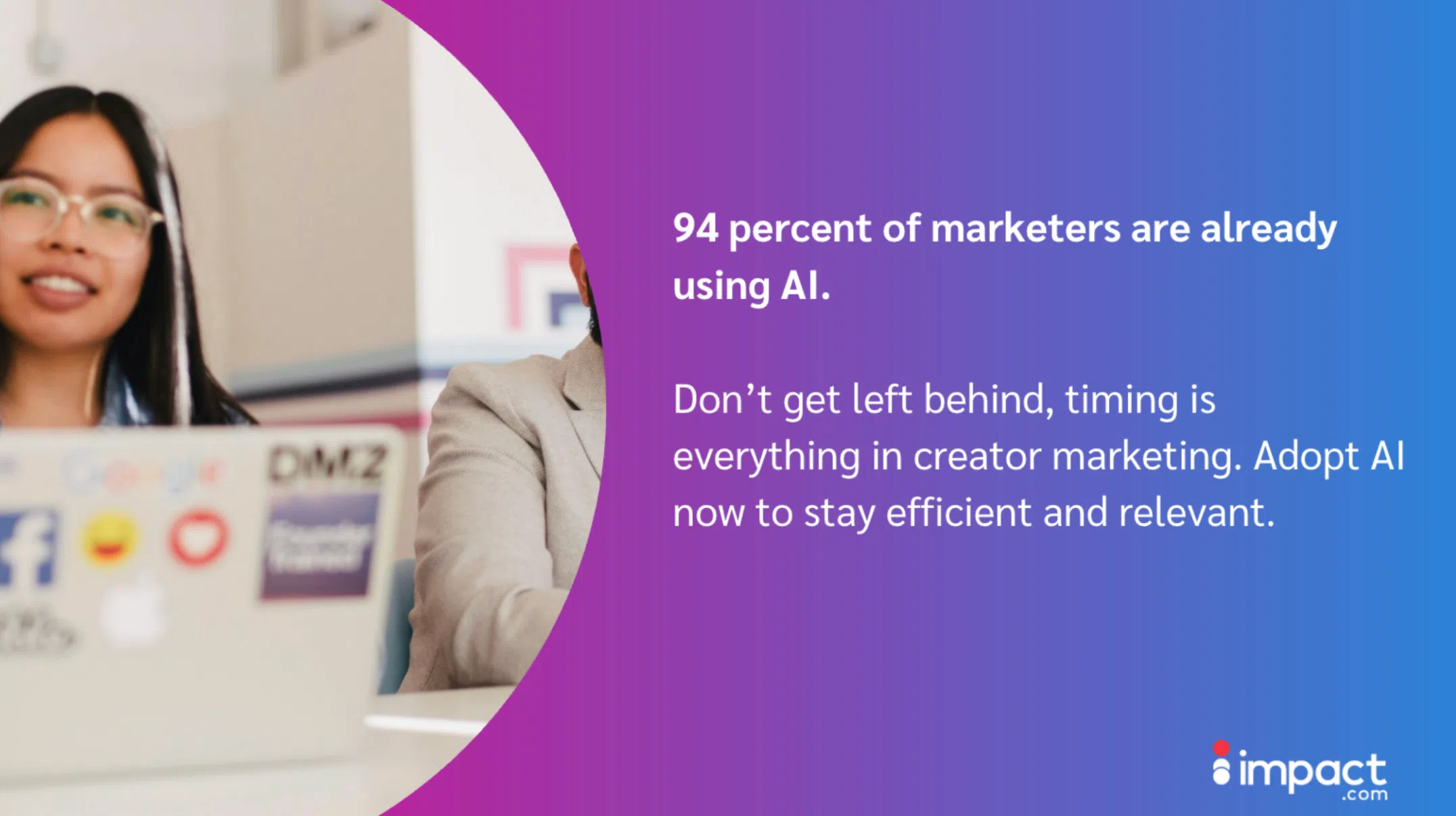
Budget allocation guidance
Securing a budget for AI takes more than excitement. It takes proof.
Traditional, manual methods make that difficult. Vanity metrics like likes and shares may look good, but they don’t relate to the bottom line and rarely move budget conversations forward.
AI changes that by connecting creator content directly to clicks, leads, and sales, allowing marketers to show real business impact. That proof strengthens the case for investment and ensures budgets go to initiatives with measurable returns.
The market trend tells the same story. The global AI-in-marketing space is set to grow from $20 billion in 2024 to $82 billion by 2030, a compound annual growth rate of 25 percent. It’s clear that AI isn’t a passing trend.
2025-2026 AI predictions
The next two years will see a shift from surface-level metrics to deeper, qualitative insights. AI’s real power isn’t in showing marketers what worked—it’s in explaining why.
New tools will dig into sentiment at scale, uncovering the emotional triggers like excitement, trust, and urgency that drive conversions.
This evolution creates a powerful feedback loop. Each campaign feeds data back into machine learning models, making the next one more precise, efficient, and effective.
We’re already seeing it in action with brands like Resident and Getty Images using AI insights to refine UGC formats.
At the same time, AI will cement its role as a co-pilot, not a replacement. Marketers are free to to focus on high-value work like building authentic creator relationships and crafting compelling brand narratives when tedious tasks get automated.
Brands like L’Oréal are already leading the way, using AI to localize campaigns at scale while empowering marketers to focus on strategy and creativity.
FAQs
The five-core functions framework is a technology-agnostic way to use AI to optimize creator campaigns and prove ROI. It tackles the manual bottlenecks that hold marketers back and focuses on five areas:
- Discovery
- Planning
- Monitoring
- Optimization
- Analysis
Instead of relying on follower counts, AI can analyze a creator’s past content and audience sentiment to uncover true brand fit. This shifts content marketing from a creative guessing game into a data-driven science.
A practical AI roadmap starts with a maturity assessment to spot your team’s biggest pain points. Don’t try to overhaul everything at once. Instead, focus on one function where efficiency gains will be most immediate.
Next, prioritize investments that directly impact business outcomes like clicks, leads, and sales. This will help justify the budget and prove ROI.
Finally, focus on change management. Position AI as a co-pilot, not a replacement. By automating repetitive tasks, AI frees your team to spend more time on the human work that matters—building relationships, shaping narratives, and driving strategy.
To measure the success of AI, track function-specific KPIs tied to real outcomes:
- Creator discovery: Hours saved on manual vetting and percentage of partners who are a true brand fit.
- Campaign planning: Predictive accuracy—how well forecasts match actual results.
- Content performance: Direct links between content and business results like clicks and sales.
- Campaign optimization: Fewer brand safety violations and higher conversions from mid-campaign adjustments.
Performance analysis: Time saved on reporting and how insights inform the next campaign.
Looking ahead, AI’s biggest impact will be in refining how marketers and creators work together and delivering deeper insights. Its true value lies in moving beyond what worked to explain why. Expect more tools that analyze sentiment and pinpoint emotional triggers that drive conversions.
Each campaign will feed data back into machine learning models, creating a feedback loop that makes the next one smarter and more effective. And while AI will automate the tedious tasks, it won’t replace marketers, it will act as a co-pilot, freeing teams to focus on relationships, creativity, and strategy.
AI optimizes campaigns in two ways: during and after.
- Mid-campaign: AI flags brand safety risks in real time and powers A/B testing, giving creators instant recommendations to boost performance on the fly.
- Post-campaign: AI generates presentation-ready reports in seconds, replacing hours of manual work. These summaries highlight top-performing channels and creators, offering insights marketers can use to refine strategy and improve future content.
Stay ahead of the competition with your AI-powered content optimization checklist
The future of content marketing belongs to brands that embrace AI. Moving beyond manual processes, AI enables data-driven excellence across every stage of a creator campaign, from discovery and planning to optimization and analysis.
To put this into action:
- Choose smarter tools: Look for predictive analytics, sentiment analysis, and strong social monitoring.
- Empower partnerships: Use AI insights to strengthen creator collaboration, not just track results.
- Prove ROI: Go beyond vanity metrics and link content to clicks, leads, and sales.
- Apply learnings: Turn campaign insights into sharper strategies and briefs for the next round.
Marketers who adopt this mindset will lead.
Ready to optimize your program with powerful AI tools? Request a demo with impact.com today.
Check out more content here:
- Building a successful influencer marketing program [worksheet]
- Creator marketing attribution models: The modern marketer’s guide in 2025 [blog]
- 2025 mid-year consumer shopping insights: How extended purchase journeys are reshaping retail partnerships [research]
- Influencer + affiliate: The growth strategy most brands overlook [blog]
- The Partnership Economy Podcast: Building a brand consumers love
